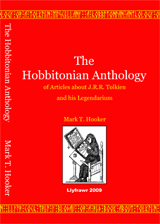 |
An Open Letter to the Editors of Tolkien StudiesIn his review of The Hobbitonian Anthology in Tolkien Studies No. 7 (pages 330-335), John D. Rateliff makes a number of misleading statements that are the result of his incomplete knowledge of the field of linguistics. This is evidenced in the review by his admitted unfamiliarity with the vocabulary of linguistics. Outside the review, this can be seen in his fallacious comment in his The History of The Hobbit (Houghton Mifflin, 2007) that Tolkien’s gloss for Esgaroth (Reed Lake) is actually a poor one for the place name of a town built on a lake. Rateliff reasons that the gloss Reed Lake would be more appropriate as a gloss for a hydronym, like The Long Lake, and that Tolkien’s use of it for the town was due to confusion on Tolkien’s part. (p. 562) Tolkien was not confused. This happens all the time in the real world. In his unfinished “Index,” Tolkien explains that although Linhir is the name of a town with a harbor and a ferry-bridge, it is “prop[erly] a river name.” (Companion, 587) The village Kenn in Devon is on the River Kenn. The village of Carno in the Montgomeryshire is named for the River Carno which passes by it. A number of British towns named in Ptolemy and the Antonine Itinerary have either a name that is identical with the rivers on which they are located, or have names that add a derivative suffix to the names of the rivers flowing past them.[1] The 1932 and 1980 Winter Olympics were hosted by the village of Lake Placid, which is on the shores of Lake Placid. In his review, Rateliff attempts to cast doubt on two statements regarding the linguistic relationship between Welsh and Hebrew, and between Welsh and Egyptian mythology. The parallels and resonances are well established, and considered common knowledge in the field. They are the subject of numerous academic studies, a select sample of which are listed below. Mr. Rateliff's comments demonstrate that he is not versed in the requisite literature, and is, therefore, jumping to an ill founded conclusion.
At another place in the review, Rateliff attempts to cast doubt on the shift of initial ‘M’ into ‘B’ in Celtic names and words as they cross language boundaries. In the Celtic languages, the interchange of ‘M’ and ‘B’ as the initial consonants of words with the same meaning is considered such common knowledge that it is the stuff of dictionaries. A number of academic dictionaries cross reference the variant spellings, for example: Geiriadur Prifysgol Cymru: A Dictionary of the Welsh Language (in four volumes), Caerdydd: Gwasg Prifsgol Cymru, 1950-1967. Tolkien imported this feature of the Celtic languages into his Elvish languages. “The Etymologies” in volume five of The History of Middle-earth attest a number of examples, including: MBAD- (duress, prison, doom, Hell) > N. band, bann (duress, prison), Q. Mando (the imprisoner); MBAS- (knead), Q. masta (bread), N. bast (bread); MBAW- (compel, force), Q. maure (need), N. baur (need). (HoMe, v, 414) This clearly demonstrates Tolkien’s awareness of the ‘M’>‘B’ shift across language boundaries. Even a Tolkien researcher who is not versed in Celtic linguistics, but who claims the competence to review a book on Tolkienian Linguistics should have been aware of this. Tolkien Studies, therefore, failed in its duty as a refereed academic journal to present accurate information in the traditions of academic integrity and fairness, by publishing a flawed review from an unqualified reviewer whose review reeks of malicious invective. 1 - Henry Bradley, “Some Prehistoric River Names,” An English Miscellany: Presented to Dr. Furnivall in Honour of his Seventy-fifth Birthday, Oxford: Clarendon Press, 1901, p. 13. |
